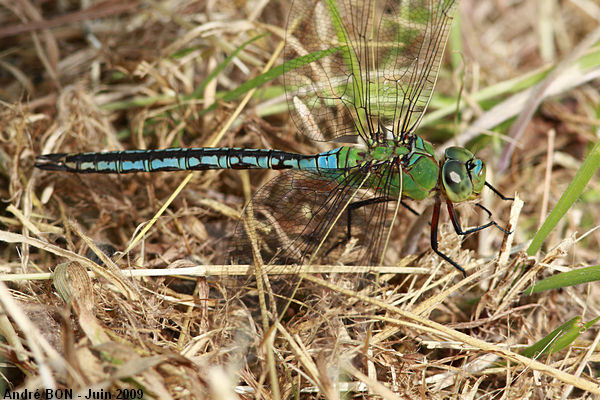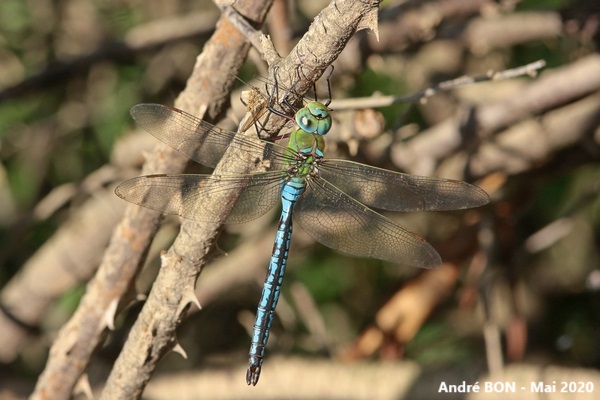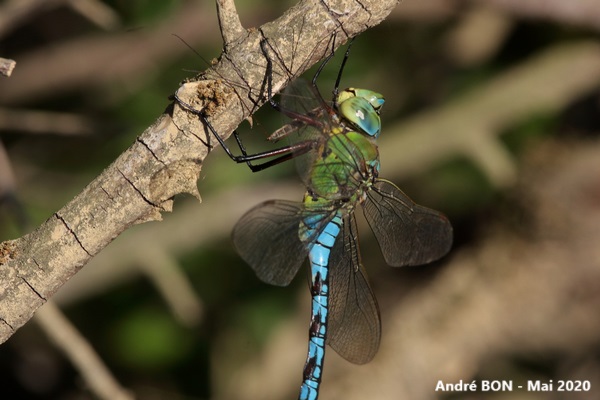





| Emperor Dragonfly (Anax imperator (Leach, 1815)) |






|
|
Scientific name: Anax imperator (Leach, 1815) Common name: Emperor Dragonfly French name: Anax empereur Order: Odonata Suborder: Anisoptera Family: Aeshnidae Wingspan: 106 mm. Biotope: Stagnant or low running water with many water vegetation, ponds, lakes, channels. Geographic area: Europe, northwards to the southern part of the British Isles and to northern Germany, Africa, Madagascar, Middle East, Central Asia. This range is extending northwards. Flight time: April to October (March to December in North Africa). |
The Emperor Dragonfly is the largest Dragonfly in Europe. The thorax is uniform green colour with a blue patch on the upper side ahead of the wings on males. Males have a light blue abdomen with a black dorsal line running along the entire length. The female's abdomen is brownish grey with dark rings. Aged females may show a bluish abdomen. The Emperor Dragonfly often lands high in the trees. It relentlessly patrol over a rather large territory. Females lay the eggs alone onto the stems of floating vegetation. The very voracious larvae have a development cycle of usually only one year. The only possible confusion is with Lesser Emperor (Anax parthenope). You can distinguish this last one by the black triangle-shaped mark ahead of the eyes (this mark has the shape of a pentagon on the Anax imperator), by the darker eyes and by the brown thorax followed by a yellow basal ring. The abdomen starts by a blue saddle which is in contrast to the following brownish segments. Anax parthenope lays the eggs in tandem on the contrary of female Anax imperator which lays the eggs alone. |
| [To know more about the Emperor Dragonfly] [Next picture] [Top] |

|
This is the first Emperor Dragonfly which has been kind to land in front of my camera, unfortunately this is down on the grass. I am still looking for another one which will enable me to shoot a picture with a beautiful uniform background. |
| [To know more about the Emperor Dragonfly] [Next picture] [Previous picture] [Top] |

|
I have seen this Emperor Dragonfly land in the far. I have succeeded in slowly walking relatively close to shoot a close-up view. |
| [To know more about the Emperor Dragonfly] [Next picture] [Previous picture] [Top] |

|
In order to make new entomological observations, I have tried to follow with my eyes one of these large dragonflies which was patrolling the clearing. This is a rather difficult task as the changes of direction are sudden and unpredictable. I was going to give up after only a few minutes when I heard some kind of buzzing sound accompanying the flight. The dragonfly still did one round turn in the clearing and then landed on a shrub on the woodland edge. This female Emperor Dragonfly had just captured one prey. As I had seen the exact landing location, I have been able to approach and shoot a few close-up pictures. Then I have tried to approach to have a side view but the dragonfly flew away to finish its meal in a quieter place. |
| [To know more about the Emperor Dragonfly] [Next picture] [Previous picture] [Top] |

|
All the Emperor Dragonflies observed perched in broad daylight are in possession of prey. It is then quite easy to approach them. |
| [To know more about the Emperor Dragonfly] [Next picture] [Previous picture] [Top] |

|
Dorsal view. |
| [To know more about the Emperor Dragonfly] [Previous picture] [Top] |

|
The prey is better visible in this close-up view, it's a Crane Fly. |